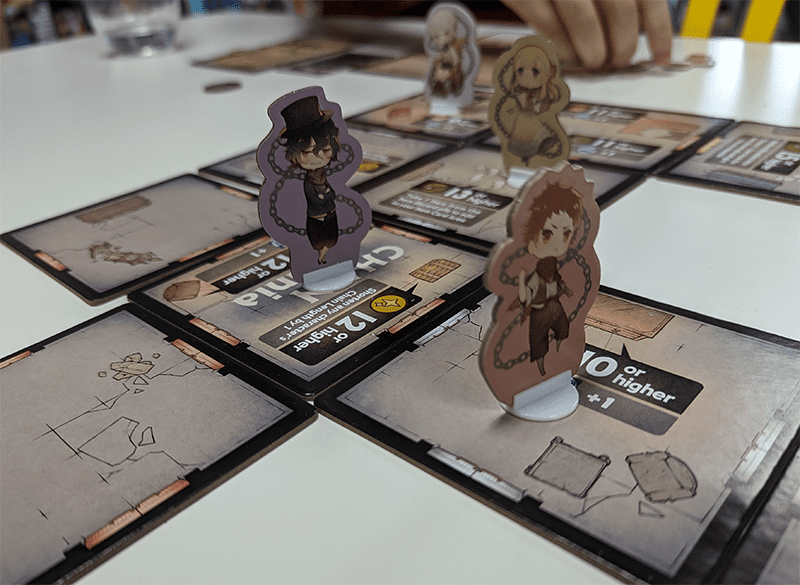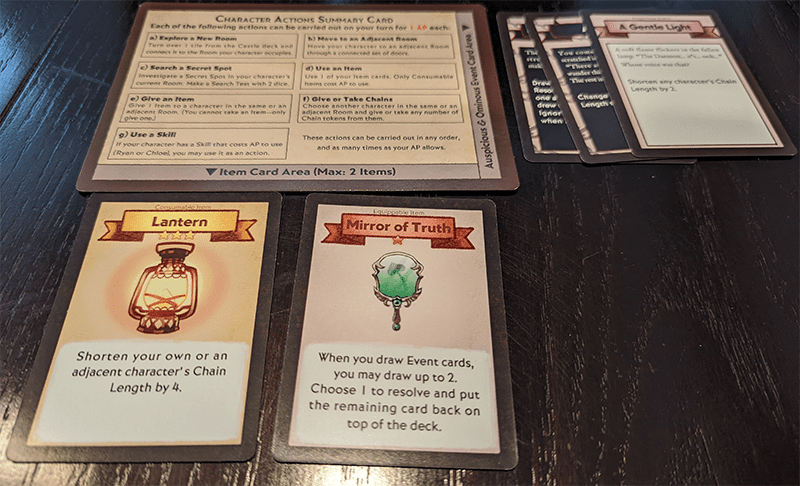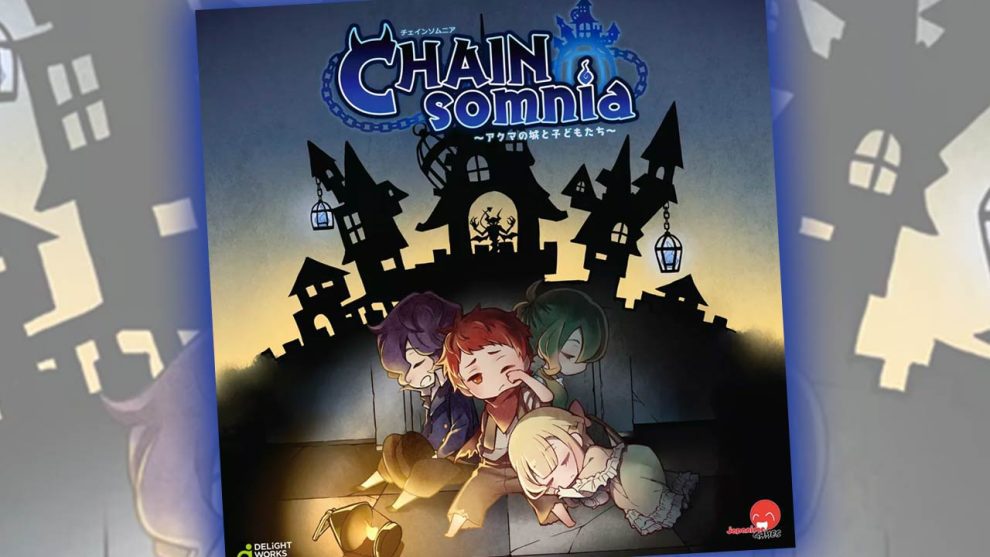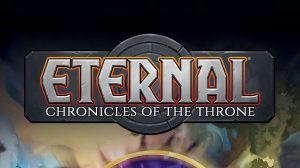Disclosure: Meeple Mountain received a free copy of this product in exchange for an honest, unbiased review. This review is not intended to be an endorsement.
What if Betrayal at House on the Hill was fully cooperative?
That was the sales pitch that got me interested in this one. It’s weird that this worked because I can’t stand Betrayal, and the many attempts to retheme the game didn’t sway me. Scooby Doo or Baldur’s Gate? Don’t care.
While my hatred towards Betrayal will probably last longer than the sun, I must confess that it does a great job seducing people to play with its simple rules. You move, draw a card, the card tells you what happens, and your turn is close to being done. Sometimes you need to roll some dice and do what it says. Non-gamers may apply here.

Typical fairy tale intro
Chainsomnia doesn’t lean too far from that path. You play as young children trapped in a dream castle run by a demon. As typical of these stories, you need to find a way out, otherwise, your soul is doomed. Typical stuff that my grandma used to read to me as a child. Polish grandmothers are built different.
You have a cast of six children with special abilities. The setup of the game isn’t that far off from Betrayal. You start with a single room tile with the four children placed in the room. There is a deck of Item cards, Event cards, and a stack of Room tiles with a Wake Up tile at the bottom. Go through all the room tiles, clear out the Bad Dreams on the map, and have one child rush to the Wake Up tile. Bad Dreams are cards that spawn from the Event deck. They block rooms, trap a child, or force you to remove items or do dice rolls.
Going through a turn is almost as simple as the game’s premise. You have Action Points and you spend them doing various things like moving to another room. The trick here is Action Points aren’t consistent from turn to turn.
On the left side of your character board is the chain length. Think of it as hit points or health. As the game progresses, the chain length will increase or decrease. At the start of your turn, you look at your chain length which determines your Action Points, or AP, for your turn.
I will state right now that this is perhaps one of my favorite mechanisms in a cooperative game. The idea of having your health tied to your AP isn’t new, but Chainsomia makes this gimmick interesting by allowing you to manipulate it and having each child with their own AP track for the chains. One isn’t impacted by it, while another doesn’t want any, and yet another wants as much as possible.
If a child has their chain length at its maximum length, you skip their turns, and having all four kids in this situation is a failure state. Another failure state is drawing Event cards with no Event cards left.

Taking action, one point at a time
As for AP, the actions you can perform aren’t unusual for what the game is going for here. You can move into a room, give items to other players, or use items. Exploring involves drawing a room tile from the stack to add to the existing map, then drawing Event cards to see what happens.
On some map tiles, there are secret spots you can use by doing a skill check. You conduct a skill check by spending an AP and rolling two dice, then adding the associated skill such as Luck or Wisdom. Most of these secret spots will give you an Item card.
Item cards are what you would expect. Some are Equippable, meaning passive powers that break the rules, while others are Consumable, where you use an AP and discard the item after its effect.
Event cards are the engine that fuels the narrative difficulty of the game. Besides Bad Dreams, you also have Auspicious and Ominous event cards. Auspicious Events give you a dose of flavor text and something good happening to your band of kids, such as shortening a chain length. Ominous Events are the opposite, forcing you to do something adverse to your party. Nightmare cards act as the game’s “checkpoints” that drastically change the game, such as Shriek cards that force you to draw more Event cards when exploring rooms.
Once everyone has taken a turn, and it goes back to the Start Player, the game (“Demon”) takes its turn by drawing Event cards that impact the Start Player. After that, the Start Player token goes clockwise, and a new round begins.
It gets everyone talking
If there is one thing I can say with confidence, Chainsomnia is one of the smoothest cooperative games I have ever played. One of the big reasons I avoid cooperative games is because new players rely on the game’s owner to lead the way.
In all my sessions for this review, the other players never shot me with questions about what to do. All the information they need to know is right there. I don’t know what event cards could show up, I don’t know what bad dreams will happen, and I don’t know which room tiles will come up. You can’t meta-game out of this because the information is random and hidden. The alpha gaming issue is almost non-existent.
I’m glad this is the case because the whole point of a cooperative game is for the players to discuss what to do as a group. Having the owner or most experienced player take charge of everyone’s actions robs them of that experience.
One subject of these discussions is managing the chains. As mentioned, you can spend an AP to take or give chains to other players. You’ll learn quickly that the game isn’t about you having the best turn, but also about setting the next player’s turn as well. You are creating a chain of productive turns.
However, this chain imagery is not limited to links; it also conveys restraint. Your friends can’t stray too far from one another because you can’t remove chains or give items if they are not adjacent. You and your friends must stick together to help each other out, yet the tile placement rules want to keep everyone separated.

So far, so good
As far as cooperative games go, Chainsomia does a lot right. You’ll have discussions about utilizing the action points, chain management, taking risks with secret spots, or exploring to reveal more Event cards. There are a lot of holes to cover in this game, and the rules make it simple for anyone to take part easily.
At first glance, Chainsomia looks like it deserves a black belt since it effortlessly crushes all other entry-level cooperative games. There is a lot to like here, from the aesthetics, its rules, and discussion topics.
However, most of my love changed when I beat the game for the first time. Notice I said beat and not win.
When you open up the box of Chainsomia, there is a white envelope instructing you to open it once you beat the game. Obviously, I won’t give too many details, but this game has multiple endings. Since this is a Japanese game, I’m not surprised.
Multiple endings aren’t new to Japanese game design. In video games, we see this often in roleplaying games, dating simulators, visual novels, and even action games. To achieve a good ending, you must meet certain conditions through the game mechanisms, not by scoring points.
Noticing the weak links
I want to like this idea, but it doesn’t hit its full potential here. Again, I won’t give details, but this game uses blind drawing from a deck of cards to fuel its difficulty. In simple terms, the game can be stacked against you if the cards aren’t in your favor. Unlike Tokyo Sidekick or Testament, there isn’t an elaborate system to prepare you for the impact of randomization.
Furthermore, the difficulty is inconsistent even if you don’t pursue the best ending. Some item cards can be absolute game changers, making other areas feel inadequate. If you are lucky enough to find the Winged Boots, you can move to any tile on the board using one AP, making the challenge disappear quicker than your investment in cryptocurrency. Another item can even make one of your dice turn to a 6 for any skill checks, removing the tension of risk management.
Because of all these features, it pushes Chainsomia into an awkward position. It has the aesthetics and rule set of a great entry-level game. I’ve introduced it to non-gamers, and they picked it up quickly because it’s just as intuitive as petting a cat. Yet when you turn it up a notch and want to take the game seriously, you see the numerous imperfections on a surface level.
Don’t get me wrong, I like and enjoy this game. Compared to other cooperative games I’ve played, this is one of the better ones aimed at an entry-level crowd. However, I can’t ignore the ringing voice in my head saying potential. The issue with a game having potential is you don’t see what the game is capable of or what it left behind, and Chainsomia could have strived for greater heights instead of mere enjoyment.












Add Comment